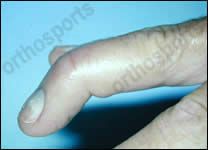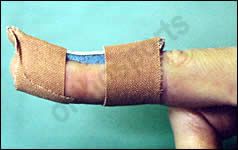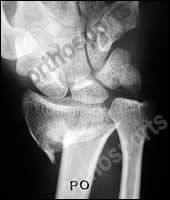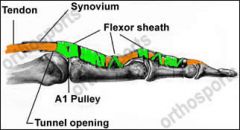![]()
![]()
![]()
Use LEFT and RIGHT arrow keys to navigate between flashcards;
Use UP and DOWN arrow keys to flip the card;
H to show hint;
A reads text to speech;
15 Cards in this Set
- Front
- Back
|
What are the carpal bones from proximal to distal, lateral to medial.
|
Scaphoid, Lunate, Triquetrium, Pisiform, Trapezium, Trapezoid, Capitate, Hamate
|
|
|
Which ligament flexes the distal phalanx?
|
Flexor digitorum profundus
|
|
|
Which ligament flexes the middle phalanx
|
flexor digitorum superficialis
|
|
|
What is the name of the ligament that connects metacarpals 2,3,4,5?
|
deep transverse metacarpal ligaments
|
|
|
The ligament covering the carpals is called the?
|
palmar carpometacarpal ligament
|
|
|
The metacarpalphalangeal joint connects what bones?
|
The metacarpal and the proximal phalanx (MP)
|
|
|
What ligament connects the proximal and middle phalanges?
|
The proximal interphalangeal joint (PIP)
|
|
|
What is the joint between the middle and distal phalanges?
|
The distal interphalangeal joint (DIP)
|
|
|
The tendon located on the posterior surface of the finger that causes extension of the finger is?
|
Extensor digitorum tendon
|
|
|
The ligaments located on th medial and lateral aspects if the MP, PIP, DIP are called.
|
collateral ligaments
|
|

What is mallet finger?
|

A sudden bending force to the tip of the finger causes a Mallet finger - e.g. tucking in the sheets while making a bed.
It can either... Stretch or Rupture the tendon,or, pull a fragment of bone off the end bone of the finger. It results in a drooping deformity at the end joint of the finger, which, if left untreated, can increase progressively with time. |
|
|
What is the treatment for a mallet finger?
|

TREATMENT
The fingertip should be held straight for 8-10weeks to allow the tendon to heal. This is followed by a period of night splinting and the use of Coban bandage during the day for 2 weeks. Note - the finger must be kept dry. The splint should be comfortable. If the finger is painful then the splint can be carefully removed and the back of the finger massaged with an alcohol swab to prevent ulcer formation. During this time the finger must be supported straight at all times. If the finger drops for even one second the treatment can fail. The splint is best reapplied with the assistance of another person. If the splint feels too tight it usually is and should be carefully adjusted. As the swelling and pain settles the splint can be bent back more to decrease the strain on the tendon. If the tape stretches new tape can be applied over the top of the old tape. The finger should feel firm in the splint. The second finger joint (P.I.P. joint) should be exercised to prevent stiffness. |
|
|
What is a Colles fracture?
|

This is the most common wrist fracture and often occurs in postmenopausal women. It usually results from a fall onto the outstretched hand and leads to the Radius (larger forearm bone) crushing into itself and tilting backwards.
A Colles fracture results in the radius shortening or conversely the ulna becomes too long and impacts against the wrist bones. Normally the radius is tilted forward approx. 10 degrees on a side view. On a front view of the wrist the radius and ulnar are approximately the same length. |
|
|
What is tennis elbow
|
Tennis elbow is basically an inflammation of the tissues in the elbow area. It plagues many racquet players and golfers, both amateur and professional. While it is most common in these sports, the problem can occur with anyone who uses the arm excessively and is most common between the ages of 35 and 55 years.
Tennis elbow involves the muscles and tendons that extend (bend back) the wrist and fingers. Quite a large group of muscles originate from a very small area of the bone. The problem usually begins when the forces exerted by the muscle become greater than the strength of the muscle itself. Typically the pain occurs on the outside of the elbow. Similar symptoms can occur on the inside of the elbow which is known as medial epicondylitis or golfer's elbow. |
|
|
There are 2 tendons acting on each finger to bend or flex the finger. The tendons run up the front of the finger in a tunnel (flexor sheath) which is lined by synovium , a lubricating tissue which allows the tendon to glide without resistance. Thickenings of the flexor sheath are called pulleys and they hold the tendon down against the bone and prevent bowstringing.
When a tendon is cut or pulls off the bone it results in bleeding up and down the sheath. The blood turns to scar tissue and hinders gliding of the tendons. Direct repair of a tendon is therefore only possible for 2–3 weeks after an injury. After this time the scaring becomes too dense and the tunnel becomes narrowed and rough thus preventing smooth gliding of the tendon. The muscle continues to act on the proximal end of the tendon. This muscle effect results in the tendon retracting so that over a period of time the gap between the divided tendon ends becomes great. |

What is Jersey finger?
|

